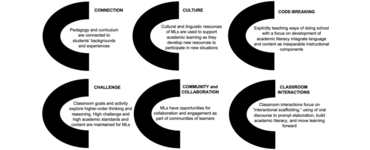“Navigating the Common Core with English Language Learners: Developing Higher-Order Thinking Skills,” by Larry Ferlazzo and Katie Sypnieski. 2016. 370 pages, paperback, $30.55 USD. ISBN 978-1-119-02300-5
Key words: ELL, Common core, higher order thinking, scaffolding, graphic organizer, modeling, https://larryferlazzo.edublogs.org/
As teachers, we have all spent time in meetings unpacking the Common Core Standards. In their book Navigating the Common Core with English Language Learners, two California high school teachers, Larry Ferlazzo and Katie Hull Sypnieski, take this unpacking a step further and address the needs of English language learners (ELLs) in light of the Common Core.
Navigating the Common Core uses both research on ELLs and the authors’ and contributors’ extensive experience working with high school ELLs to bring the reader practical, scaffolded ideas for developing higher-order thinking skills that the Common Core now requires of all learners, including ELLs. One of the writers’ best successes toward this goal can be seen in the very explicit lesson examples. In a section on the importance of questions, for instance, the authors first introduce literal and interpretive questions through modeling. They go on to discuss different question starters for each category. Then, using a graphic organizer, students are led to develop interpretive questions for a history unit. Finally, the authors give an example of what they call a “test in reverse,” where students are given the test answers and must come up with the matching literal and/or interpretive questions (p. 38).
The book is divided into nine chapters. The first chapter gives a valuable overview of ELLs and the Common Core. It is followed by a timely chapter addressing the importance of social emotional learning (SEL) in an ELL’s route to successfully navigating the Common Core. Practical, ready-to-use lessons on goal-setting, metacognition, critical thinking, creativity/innovation, self-control, and persistence/resilience are included. Chapters 3, 4, and 5 each delve into a separate domain of language learning, namely, reading, writing, and speaking/listening. These chapters, as well as Chapter 6, on language, follow a similar format. The Common Core standards are unpacked and translated to answer the question, “What does this mean in my classroom?” Next, clear examples of lessons are shared. The final Chapters 7, 8, and 9 address the areas of mathematics, social studies, and science, incorporating the work of experienced content teachers as contributors in these specialized subject areas. This change in authorship is notable in the change of format and tone. At the end of the book, readers will find a very extensive index that teachers will find very useful for locating additional information.
One chapter that I found particularly useful was Chapter 5 on speaking and listening. This chapter identifies the Common Core requirements of comprehension and collaboration and of presentation of knowledge and ideas. As a teacher of very young learners, I believe that nearly all of the suggestions given in this chapter are easily adaptable to any age. The authors start with the necessary classroom environment for successful discussion: one which is safe, provides tasks at the right level, where the student participation is authentic, and there is student ownership. They also emphasize what they call the iron rule, “Never do for others what they can do for themselves.”
This chapter gives a simple but potentially impactful exercise for practicing active listening by having a student identify what it looks like and what it does not look like, then demonstrating both with a peer. This amounts to metacognitive listening, which is valuable for anyone. Two other examples of easily adaptable ideas from this chapter are “elevator pitches” and using speaker frames, which could easily be taught in an elementary school show-and-tell setting, beginning to expose students to presentation skills. The sentence frames for discussion, such as I think that…, could also be chosen for any level.
Rather than just telling teachers what they could use in class, the authors provide many specific examples, graphic organizers, sentence frames for responses, and follow-up work and extensions, including online resources. One author, Larry Ferlazzo, has written and compiled useful information in his extensive blog. Ferlazzo provides the titles to information in his blog for easy retrieval. Additionally, downloadable lesson plans and handouts are given. While the book is a valuable tool for teachers as is, two bonus online chapters are provided that address how teachers can use art with ELLs and how school counselors can provide both student and teacher support.
While there are some lessons for beginning ELLs, the authors have written the book for more advanced learners. However, their boots-on-the-ground approach gives teachers practical strategies for scaffolding Common Core tasks, particularly with their emphasis on higher-order thinking, in a manner that can lead to success with our ELLs. Even though the book was not directed at me, a kindergarten teacher, I still found there were many take-aways that I could adapt for my classroom.
While the chapters on mathematics, science, and social studies also contained practical ideas, I wish Ferlazzo and Sypnieski had required the writers of these three chapters to follow the same format of the earlier chapters, as this would have given the work more continuity of voice and perhaps leveled the language and content for ease of both reading and use. The Common Core asks for higher-level thinking right out of the gate, so while the specific lessons may be geared to more advanced students in secondary schools, good teaching is good teaching. Teachers at any level can glean valuable ideas for ELLs and reflect on their own teaching by reading this book, especially the first six chapters. They will also know that what they have read is grounded in research and experience.
Though this book is four years old, the content is still of great interest to teachers today. In particular, teachers who are new to working with ELLs may find implementing Common Core with this student population to be a somewhat daunting task, but Navigating the Common Core with English Language Learners: Developing Higher-Order Thinking Skills can certainly help all teachers as they work with their ELL populations. Perhaps the two strongest features of this book are the teacher-friendly accessible language used to explain the concepts and the extensive inclusion of classroom-ready materials. For these reasons and many others, I strongly recommend this book to ELL teachers.
Reference:
Ferlazzo, L., & Sypnieski, K. (2016). Navigating the common core with English language learners: Developing higher-order thinking skills. Jossey-Bass.








